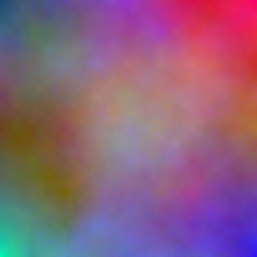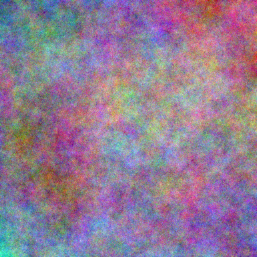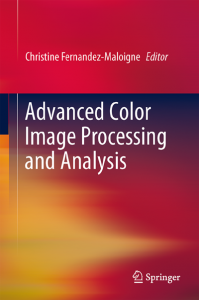Scientific interest and domains of expertise
- color and multispectral image processing and analysis
- algorithms and data structures
- computational and artificial intelligence
- parallel algorithms and architectures, GPU programming
- parallel calculus for bioinformatics
Keywords: fractal geometry, mathematical morphology, texture analysis, image segmentation, MPEG, informational energy, SVM, GPU, CUDA, OpenCL
Fractal models for color texture analysis allow for color fractal texture generation with known characteristics, as well as for the analysis of color texture complexity. The models are accompanied by fractal measures (color fractal dimension, lacunarity) extended to the color domain. The plethora of applications includes: the qualitative study of surfaces, texture classification, image segmentation and indexing.
The following color fractal images have increased complexity (H=0.9, 0.5 and 0.1 respectively).
The complete series of 9 images with H=0.9 to H=0.1 is available here [download]. Please refer to M. Ivanovici, N. Richard – Fractal Dimension of Color Fractal Images, IEEE Transactions on Image Processing, vol. 20, issue 1, January 2011 for the generation of these color fractal images.
Download the Matlab code for estimating the color probabilistic box-counting fractal dimension here: [probboxcountingcolor.m]
Download the Matlab code for estimating the color probabilistic box-counting fractal lacunarity here: [colorlacunarity.m]
Color image segmentation approaches using texture analysis, fractal geometry and mathematical morphology, active contours, with medical application – dermatological image and computed tomography sequence analysis. Segmentation usually precedes the detection or recognition operations and can be used in any application for region of interest identification based on specific criteria and a priori information.
See M. Ivanovici, N. Richard, D. Paulus, “Color Image Segmentation”, in Advanced Color Image Processing and Analysis, ed. Christine Fernandez-Maloigne, Springer New York, 2013
N-dimensional camera applications (Microsoft Kinect and Time of Flight cameras) for humanoid animation, video games, movement tracking for one or more persons. The research performed together with the GRIN laboratory, Institute Mines-Télécom, Evry, France lead to a contribution to the MPEG standard: MPEG-V ISO/IEC JTC1/ SC29/WG11 MPEG2012/M26808 – V.A. Nica, M. Ivanovici, M. Preda, “XML Scheme and Description for Camera Sensor Type”, 102th MPEG Meeting, Shanghai, China, 2012. The developed algorithms aim at finding key points in images or video sequences by processing both color and depth information about the analyzed scene.
Applications in biochemistry and bioinformatics. We developed various parallel algorithms on multi-core and GPU platforms, in order to determine the 3D structure of proteins based on the inter-atom distances obtained by spectrographic methods. The structure is very important in biochemistry because it determines the biochemical properties of the protein, as well as its interaction with a certain inhibitor.
Machine learning paradigms. An original aspect of our research is the usage of Onicescu’s informational energy in data mining and machine learning problems. Our focus is on large data sets (big data) and small data sets (small data). In the case of big data, the learning mechanism have to be computational efficient, while the small data are usually not enough for building an adaptive model. Thus, we address problems of extreme data mining.
Improved SVM model. Support Vector Machine is an efficient model for automatic classification. We improved this online learning model and contributed to its efficient implementation.



